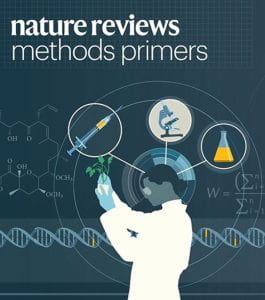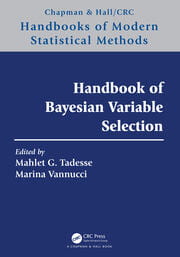Dr. Vannucci is generally interested in the development of Bayesian statistical models for complex problems and applications to Science. Her methodological research has focused in particular on the development of wavelet-based models for functional data, on the theory and practice of Bayesian variable selection techniques, and on graphical models. Dr. Vannucci’s methodological research is often motivated by real problems that need to be addressed with suitable statistical methods. Her interdisciplinary focus has been on high-throughput genomics and, more recently, on neuroimaging and neuroscience.
Theory & Methods: Bayesian inference, Graphical models, Statistical computing, Variable selection and Wavelets.
Applications: Engineering, Large-scale Genomics, Neuroimaging & Neuroscience.
Main methodological contributions have included:
 (i) Wavelet-based Models for Functional Data
(i) Wavelet-based Models for Functional Data
Dr. Vannucci has contributed innovative Bayesian models for wavelet shrinkage with random wavelet coefficients, incorporating efficient algorithms for the computation of their covariances; for wavelet-based regression modeling of functional data, including curve regression and hierarchical models; and for classification models based on functional data. Other work has broadly related to the modeling of time series data, with various applications.
- Vannucci, M. and Corradi, F. (1999). Covariance Structure of Wavelet Coefficients: Theory and Models in a Bayesian Perspective. Journal of the Royal Statistical Society, Series B, 61(4), 971-986.
- Brown, P.J., Fearn, T. and Vannucci, M. (2001). Bayesian Wavelet Regression on Curves with Application to a Spectroscopic Calibration Problem. Journal of the American Statistical Association, 96, 398-408.
- Morris, J.S., Vannucci, M., Brown, P.J. and Carroll, R.J. (2003). Wavelet-Based Nonparametric Modeling of Hierarchical Functions in Colon Carcinogenesis (with discussion). Journal of the American Statistical Association, 98, 573-597.
- Park, C.G., Vannucci, M. and Hart, J.D. (2005). Bayesian Methods for Wavelet Series in Single-Index Models. Journal of Computational and Graphical Statistics, 14(4), 770-794.
- Ko, K. and Vannucci, M. (2006). Bayesian Wavelet Analysis of Autoregressive Fractionally Integrated Moving-Average Processes. Journal of Statistical Planning and Inference, 136(10), 3415-3434.
- Ko, K., Qu, L. and Vannucci, M. (2009). Wavelet-based Bayesian Estimation of Partially Linear Regression Models with Long Memory Errors. Statistica Sinica, 19(4), 1463-1478.
- Zhu, H., Vannucci, M. and Cox, D.D. (2010). A Bayesian Hierarchical Model for Classification with Selection of Functional Predictors. Biometrics, 66(2), 463-473.
- Stingo, F.C., Vannucci, M. and Downey, G. (2012). Bayesian Wavelet-based Curve Classification via Discriminant Analysis with Markov Random Tree Priors. Statistica Sinica, 22, 465-488.
- ————————————————————————————————
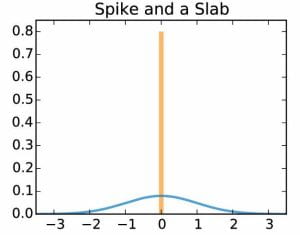 (ii) Bayesian Variable Selection
(ii) Bayesian Variable Selection
Dr. Vannucci has contributed original approaches to Bayesian variable selection in multivariate regression models, extending models that use mixture prior distributions with a spike at zero, and investigating efficient stochastic search MCMC algorithms that cleverly deal with the changing dimension of the parameter space; innovative ways to perform Bayesian variable selection for sample clustering, with both finite and infinite mixture models; and extensions to various modeling settings for non-Gaussian (e.g., categorical, count and compositional) data. Other methodological contributions to Bayesian variable selection have included explorations of priors that incorporate point masses in nonparametric constructions.
- Brown, P.J., Vannucci, M. and Fearn, T. (1998). Multivariate Bayesian Variable Selection and Prediction. Journal of the Royal Statistical Society, Series B, 60(3), 627-641.
- Brown, P.J., Vannucci, M. and Fearn, T. (2002). Bayes Model Averaging with Selection of Regressors. Journal of the Royal Statistical Society, Series B, 64(3), 519-536.
- Sha, N., Vannucci, M., Tadesse, M.G., Brown, P.J., Dragoni, I., Davies, N., Roberts, T.C., Contestabile, A., Salmon, N., Buckley, C. and Falciani, F. (2004). Bayesian Variable Selection in Multinomial Probit Models to Identify Molecular Signatures of Disease Stage. Biometrics, 60(3), 812-819.
- Tadesse, M.G., Sha, N. and Vannucci, M. (2005). Bayesian Variable Selection in Clustering High-Dimensional Data. Journal of the American Statistical Association, 100, 602-617.
- Kim, S., Tadesse, M.G. and Vannucci, M. (2006). Variable Selection in Clustering via Dirichlet Process Mixture Models. Biometrika, 93(4), 877-893.
- Kim, S., Dahl, D.B. and Vannucci, M. (2009). Spiked Dirichlet Process Prior for Bayesian Multiple Hypothesis Testing in Random Effects Models. Bayesian Analysis, 4(4), 707-732.
- Kwon, D.W., Landi, M.T., Vannucci, M., Issaq, H.J., Prieto, D. and Pfeiffer, R.M. (2011). An Efficient Stochastic Search for Bayesian Variable Selection with High-Dimensional Correlated Predictors. Computational Statistics and Data Analysis, 55(10), 2807-2818
- Savitsky, T., Vannucci, M. and Sha, N. (2011). Variable Selection for Nonparametric Gaussian Process Priors: Models and Computational Strategies. Statistical Science, 26(1), 130-149.
- Li, Q., Guindani, M., Reich, B.J., Bondell, H.D. and Vannucci, M. (2017). A Bayesian Mixture Model for Clustering and Selection of Feature Occurrence Rates under Mean Constraints. Statistical Analysis and Data Mining, 10(6), 393-409.
- Li, Q., Cassese, A., Guindani, M. and Vannucci, M. (2019). Bayesian Negative Binomial Mixture Regression Models for the Analysis of Sequence Count and Methylation Data. Biometrics, 75(1), 183-192.
- Cassese, A., Zhu, W., Guindani, M. and Vannucci, M. (2019). A Bayesian Nonparametric Spiked Process Prior for Dynamic Model Selection. Bayesian Analysis, 14(2), 553-572.
- Liang, M., Koslovsky, M.D., Hebert, E.T., Businelle, M.S. and Vannucci, M. (2024) Functional Concurrent Regression Mixture Models Using Spiked Ewens-Pitman Attraction Priors. Bayesian Analysis, accepted.
- ————————————————————————————————
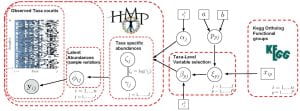 (iii) A particular focus of Dr. Vannucci’s work has been in the development of integrative models that combine multiple data types, for dedicated applications to large-scale genomics (e.g., DNA microarray, proteomics), imaging genetics and microbiome studies. The development of these complex models has often been coupled with innovative variable selection prior constructions, that account for specific dependence structures in the data (e.g., spatial and network relationships), and efficient sampling algorithms for posterior inference.
(iii) A particular focus of Dr. Vannucci’s work has been in the development of integrative models that combine multiple data types, for dedicated applications to large-scale genomics (e.g., DNA microarray, proteomics), imaging genetics and microbiome studies. The development of these complex models has often been coupled with innovative variable selection prior constructions, that account for specific dependence structures in the data (e.g., spatial and network relationships), and efficient sampling algorithms for posterior inference.
- Lee, K.E., Sha, N., Dougherty, E., Vannucci, M. and Mallick, B.K. (2003). Gene Selection: A Bayesian Variable Selection Approach. Bioinformatics, 19(1), 90-97.
- Tadesse, M.G., Vannucci, M. and Lio, P. (2004). Identification of DNA Regulatory Motifs using Bayesian Variable Selection. Bioinformatics, 20(16), 2553-2561.
- Kwon, D.W., Tadesse, M.G., Sha, N., Pfeiffer, R.M. and Vannucci, M. (2007). Identifying Biomarkers from Mass Spectrometry Data with Ordinal Outcome. Cancer Informatics, 3, 19-28.
- Stingo, F.C., Chen, Y.A., Vannucci, M., Barrier, M. and Mirkes, P.E. (2010). A Bayesian Graphical Modeling Approach to MicroRNA Regulatory Network Inference. Annals of Applied Statistics, 4(4), 2024-2048.
- Stingo, F.C., Chen Y.A., Tadesse, M.G. and Vannucci, M. (2011). Incorporating Biological Information into Linear Models: A Bayesian Approach to the Selection of Pathways and Genes. Annals of Applied Statistics, 5(3), 1978-2002.
- Stingo, F.C., Guindani, M., Vannucci, M. and Calhoun, V. (2013). An Integrative Bayesian Modeling Approach to Imaging Genetics. Journal of the American Statistical Association, 108, 876-891.
- Cassese, A., Guindani, M., Tadesse, M., Falciani, F. and Vannucci, M. (2014). A Hierarchical Bayesian Model for Inference on Copy Number Variants and their Association to Gene Expression. Annals of Applied Statistics, 8(1), 148-175.
- Wadsworth, D., Argiento, R., Guindani, M., Galloway-Pena, J., Shelburne, S.A. and Vannucci, M. (2017). An Integrative Bayesian Dirichlet-Multinomial Regression Model for the Analysis of Taxonomic Abundances in Microbiome Data. BMC Bioinformatics, 18:94, DOI 10.1186/s12859-017-1516-0.
- Koslovsky, M.D., Hoffman, K.L., Daniel, C.R. and Vannucci, M. (2020). A Bayesian Model of Microbiome Data for Simultaneous Identification of Covariate Associations and Prediction of Phenotypic Outcomes. Annals of Applied Statistics, 14(3), 1471-1492.
- Fu, J., Koslovsky, M.D. and Vannucci, M. (2023). A Bayesian Joint Model for Mediation Effect Selection in Compositional Microbiome Data. Statistics in Medicine, 42(17), 2999-3015.
- ————————————————————————————————
Dr. Vannucci has developed innovative Bayesian models for the estimation of multiple graphs in situations where some of the graphs may be unrelated, while others share common features. Attention has been given to prior constructions that allow to share information between graphs, when appropriate. Other contributions have been in the development of robust modeling and in latent graphical modeling settings for non-Gaussian data, with efficient implementations that employ variational schemes.
- Peterson, C.B., Stingo, F.C. and Vannucci, M. (2015). Bayesian Inference of Multiple Gaussian Graphical Models. Journal of the American Statistical Association, 110, 159-174.
- Peterson, C.B., Stingo, F.C. and Vannucci, M. (2016). Joint Bayesian Variable and Graph Selection for Regression Models with Network-Structured Predictors. Statistics in Medicine, 35(7), 1017-1031.
- Cremaschi, A., Argiento, R., Shoemaker, K., Peterson, C.B. and Vannucci M. (2019). Hierarchical Normalized Completely Random Measures for Robust Graphical Modeling. Bayesian Analysis, 14(4), 1271-1301.
- Shaddox, E., Peterson, C.B., Stingo, F.C., Hanania, N., Cruickshank-Quinn, C., Kechris, K., Bowler, R. and Vannucci, M. (2020). Bayesian Inference of Networks Across Multiple Sample Groups and Data Types. Biostatistics, 21(3), 561-576.
- Peterson, C.B., Osborne, N., Stingo, F., Bourgeat, P., Doecke, J.D. and Vannucci, M. (2020). Bayesian Modeling of Multiple Structural Connectivity Networks During the Progression of Alzheimer’s Disease. Biometrics, 76(4), 1120-1132.
- Osborne, N., Peterson, C.B. and Vannucci, M. (2022). Latent Network Estimation and Variable Selection for Compositional Data via Variational EM. Journal of Computational and Graphical Statistics, 31(1), 163-175.
- Liu, C., Kowal, D.R. and Vannucci, M. (2022). Dynamic and Robust Bayesian Graphical Models. Statistics and Computing, 32, 105.
- Ni, Y., Baladandayuthapani, V., Vannucci, M. and Stingo, F.C. (2022). Bayesian Graphical Models for Modern Biological Applications (with discussion and rejoinder). Statistical Methods and Applications, 31, 197-225.
- ————————————————————————————————
Main interdisciplinary efforts have included:
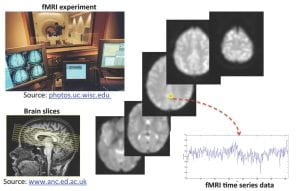 (i) Neuroimaging and Brain Connectivity
(i) Neuroimaging and Brain Connectivity
Dr. Vannucci’s methodological innovations in neuroimaging include innovative spatio-temporal Bayesian models for the detection of activated brain regions in task-based fMRI studies, and multi-subject vector autoregressive (VAR) models for the estimation of brain connectivity networks, e.g., how brain regions interact and share information with each other. Methods were implemented via scalable variational Bayes algorithms and standalone user-friendly MATLAB GUIs, to facilitate adoption from the broader community. Other contributions include integrative models for multi-modal data and original principled Bayesian approaches for the estimation of dynamic, e.g, time-varying, brain connectivity. Methodological developments have been motivated and supported by several interdisciplinary collaborations, e.g, in epilepsy and traumatic brain injury research, and by behavioral and cognitive studies.
- Zhang, L., Guindani, M., Versace, F. and Vannucci, M. (2014). A Spatio-Temporal Nonparametric Bayesian Variable Selection Model of fMRI Data for Clustering Correlated Time Courses. NeuroImage, 95, 162-175.
- Zhang, L., Guindani, M., Versace, F., Engelmann, J.M. and Vannucci, M. (2016). A Spatio-Temporal Nonparametric Bayesian Model of Multi-Subject fMRI Data. Annals of Applied Statistics, 10(2), 638-666.
- Chiang, S., Guindani, M., Yeh, H.J., Haneef, Z., Stern, J.M. and Vannucci, M. (2017). A Bayesian Vector Autoregressive Model for Multi-Subject Effective Connectivity Inference using Multi-Modal Neuroimaging Data. Human Brain Mapping, 38, 1311-1332.
- Chiang, S., Guindani, M., Yeh, H-J., Dewar, S., Haneef, Z., Stern, J.M. and Vannucci, M. (2017). A Hierarchical Bayesian Model for the Identification of PET Markers Associated to the Prediction of Surgical Outcome After Anterior Temporal Lobe Resection. Frontiers in Neuroscience, 11:669, doi: 10.3389/fnins.2017.00669.
- Warnick, R., Guindani, M., Erhardt, E., Allen, E., Calhoun, V. and Vannucci, M. (2018). A Bayesian Approach for Estimating Dynamic Functional Network Connectivity in fMRI Data. Journal of the American Statistical Association, 113, 134-151.
- Fischer-Baum, S., Kook, J.-H., Lee, Y., Ramos-Nunez, A. and Vannucci, M. (2018). Individual Differences in the Neural and Cognitive Mechanism of Single Word Reading. Frontiers in Human Neuroscience, 12:271, doi: 10.3389/fnhum.2018.00271.
- Kook, J.H., Guindani, M., Zhang, L. and Vannucci, M. (2019). NPBayes-fMRI: Nonparametric Bayesian General Linear Models for Single- and Multi-Subject fMRI Data. Statistics in Biosciences, 11(1), 3-21.
- Kook, J.H., Vaughn, K., DeMaster, D., Ewing-Cobbs, L. and Vannucci, M. (2021). BVAR-Connect: A Variational Bayes Approach to Multi-Subject Vector Autoregressive Models for Inference on Brain Connectivity Networks. Neuroinformatics, 19, 39–56.
- Vaughn, K.A., DeMaster, D., Kook, J.H., Vannucci, M. and Ewing-Cobbs, L. (2022). Effective Connectivity in the Default Mode Network after Paediatric Traumatic Brain Injury. European Journal of Neuroscience, 55(1), 318-336.
- Godlewska, B., DeMaster, D., Liang, M., Vannucci, M., Bockmann, T., Bo, C. and Selvaraj, S. (2022). Effective Connectivity between Resting-State Networks in Depression. Journal of Affective Disorders, 307, 79-86.
- ————————————————————————————————
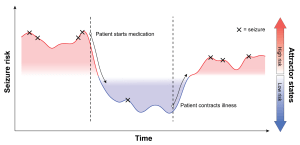 (ii) Epilepsy and Seizure Risk Estimation
(ii) Epilepsy and Seizure Risk Estimation
As co-leader, with former student Sharon Chiang (Ph.D./M.D.), of an interdisciplinary team in epilepsy research, Dr. Vannucci has shown how seizure risk of epileptic patients can be estimated as a latent quantity based on their seizure counts. Approaches she has developed include novel hidden Markov models with variable selection priors, for the identification of drivers of seizure risk cycles, and dynamical system frameworks to better understand and predict the timing of seizures. Methods have also been extended to the analysis of data from surgically implanted devices for brain neurostimulation.
- Chiang, S., Vannucci, M., Goldenholz, D., Moss, R. and Stern, J.M. (2018). Epilepsy as a Dynamic Disease: A Bayesian Model for Differentiating Seizure Risk from Natural Variability. Epilepsia Open, 3(2):236–246.
[Winner of the 2019 Epilepsia OPEN Prize in Clinical Science] - Chiang, S., Goldenholz, D.M., Moss, R., Rao, V.R., Haneef, Z., Theodore, W.H., Kleen, J., Gavvala, J., Vannucci, M. and Stern, J.M. (2020). Prospective Validation Study of an Epilepsy Seizure Risk System for Outpatient Evaluation. Epilepsia, 61, 29–38.
- Chiang, S., Khambhati, A.N., Wang, E.T., Vannucci, M., Chang, E.F. and Rao, V.R. (2021). Evidence of State-Dependence in the Effectiveness of Responsive Neurostimulation for Seizure Modulation. Brain Stimulation, 14(2), 366-375.
- Wang, E.T.,Vannucci, M., Haneef, Z., Moss, R., Rao, V.R. and Chiang, S. (2022). A Bayesian Switching Linear Dynamical System for Estimating Seizure Chronotypes. Proceedings of the National Academy of Sciences, 119(46), e2200822119.6.
- Wang, E.T., Chiang, S., Cleboski, S., Rao, V.R., Vannucci, M. and Haneef, Z. (2022). Seizure Count Forecasting to Aid Diagnostic Testing in Epilepsy. Epilepsia, 63(12), 3156-3167.
- Wang, E.T., Chiang, S., Haneef, Z., Rao, V.R., Moss, R. and Vannucci, M. (2023). Bayesian Non-Homogeneous Hidden Markov Model with Variable Selection for Investigating Drivers of Seizure Risk Cycling. Annals of Applied Statistics, 17(1), 333-356.
- ————————————————————————————————
Together with 9 other authors, Dr. Vannucci has contributed to the highly cited article “Bayesian Statistics and Modeling”, appeared in 2021 as article 1 in vol. 1 of Nature Reviews Methods Primer.
Dr. Vannucci is co-editor (with Mahlet G. Tadesse) of the 2021 Handbook of Bayesian Variable Selection, published by Chapman & Hall/CRC. The book is a comprehensive review of theoretical, methodological and computational aspects of Bayesian variable selection methods, spanning over 30 years of research on these topics.
Dr. Vannucci is co-editor (with Sharon Chiang and Vikram Rao) of the 2024 Statistical Methods in Epilepsy edited volume, published by Chapman & Hall/CRC. The book provides a comprehensive introduction to statistical methods employed in epilepsy research, as a practical roadmap for learners and experts alike.
See here for a complete list of Dr. Vannucci’s papers.
Dr. Vannucci’s research has been supported by:


